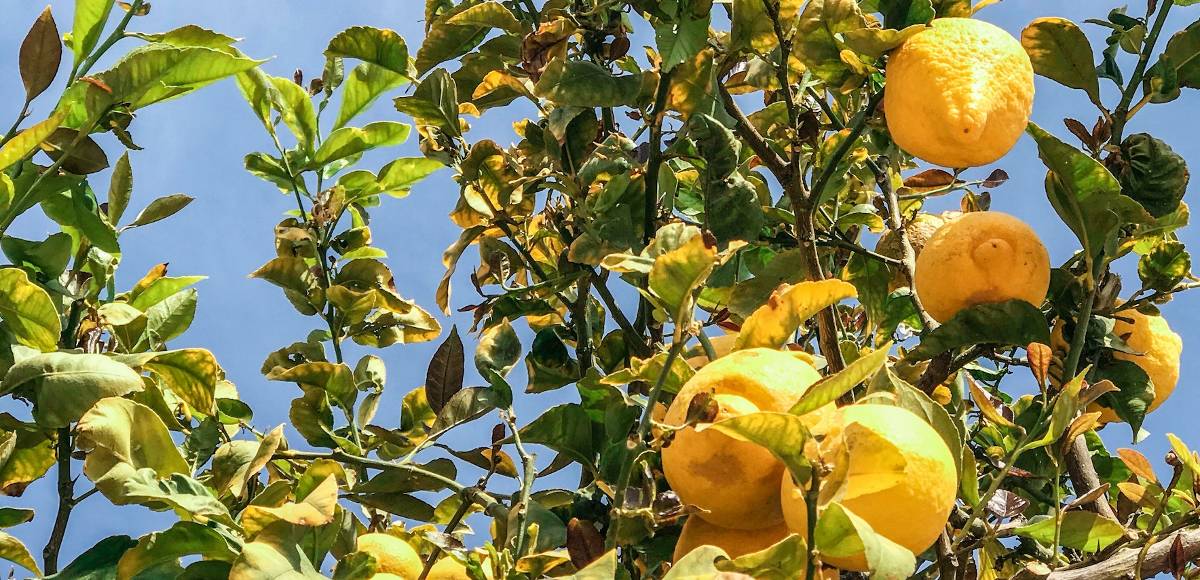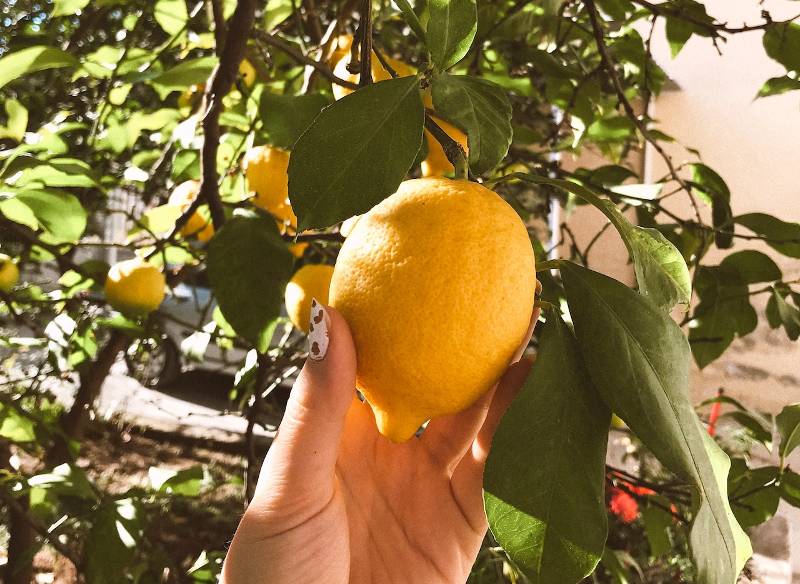When you give yourself a lemon tree, life, and your tree will give you lemons (hopefully.) Lemon trees are popular because people love having fresh lemon juice for cooking, making lemonade, and even relishing in the presence of something they’ve grown. Grown outdoors in your yard, or indoors, lemon trees are charming and loved by most. While it is possible to graft and plant branch cuttings to clone lemon trees, most are grown from seed.
If you’re just getting into growing fruit trees, germinating a lemon from seed is a great place to start. Lemon trees are forgiving, grow quickly, and can fruit as early as within a few years, which is much faster than the majority of other fruit trees. We have classified the growth of lemon trees into 8 stages. Without further ado, let’s jump into the growth stages of lemon trees.
Growth Stage 1: Lemon Seed Germination
Lemon seed germination is a process that involves sprouting a new lemon tree from seed. It is a rewarding and satisfying process that anyone can do. Lemon seeds are readily available and can be easily obtained from any fresh seeded lemon fruit (there are seedless varieties so know that before you make your selection to make sure you don’t get duped.) The germination process involves creating the ideal environment for the seed to sprout and grow. There are various ways to sprout a lemon seed. With proper care and attention, anyone can grow a lemon tree from a seed.
Lemon seed germination can take anywhere from five days to four weeks, depending on the conditions and the quality of the seeds. Some seeds may not sprout at all, while others may produce weak or stunted seedlings. It is important to be patient and persistent when attempting to grow a lemon tree from a seed.
At this stage the sprouts will be an inch or less tall and the roots will be 1 1/2″ to 2 or more inches long.
Growth Stage 2: Young Seedling Growth
The growth of a lemon seedling is a fascinating process that requires proper care and attention to ensure a healthy and robust plant. The sprouts in this stage are extremely delicate so please handle them with care.
Once the lemon seed has sprouted and the seedling has emerged from the soil, it is important to provide the plant with adequate sunlight and water. Lemon trees require at least 6 to 8 hours of sunlight each day to grow properly. If growing the seedling indoors, a south-facing window sill or a grow light can be used to provide the required sunlight or UV rays. The soil should be kept consistently moist, but not waterlogged, to prevent the roots from rotting.
As the lemon seedling grows, it will develop new leaves and branches. It is important to monitor the plant for any signs of pests or disease, as these can hinder the growth and health of the plant.
This stage will last approximately three months. The sprouts will be likely be anywhere from 2″ to 8″ tall.
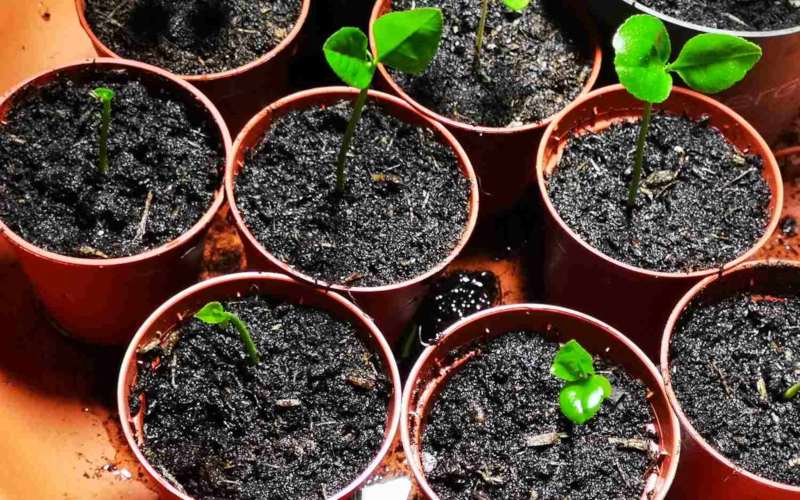
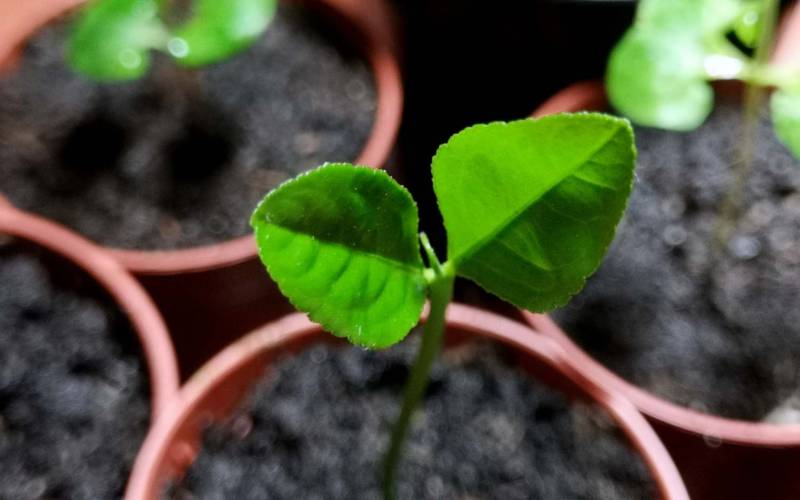
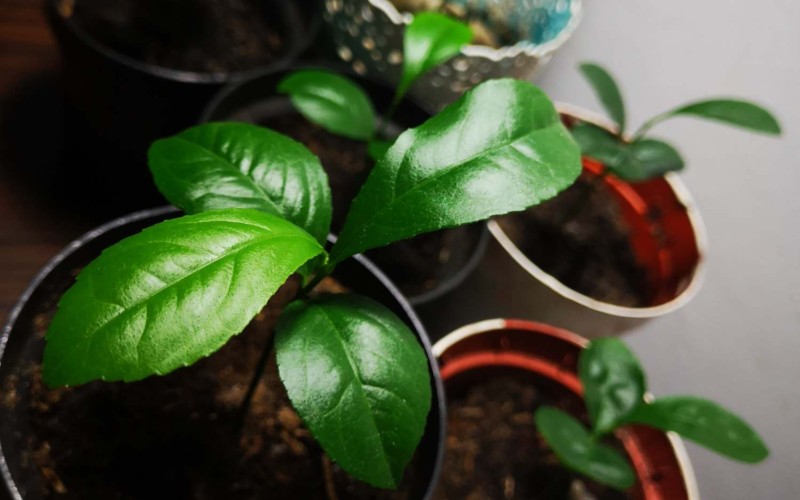
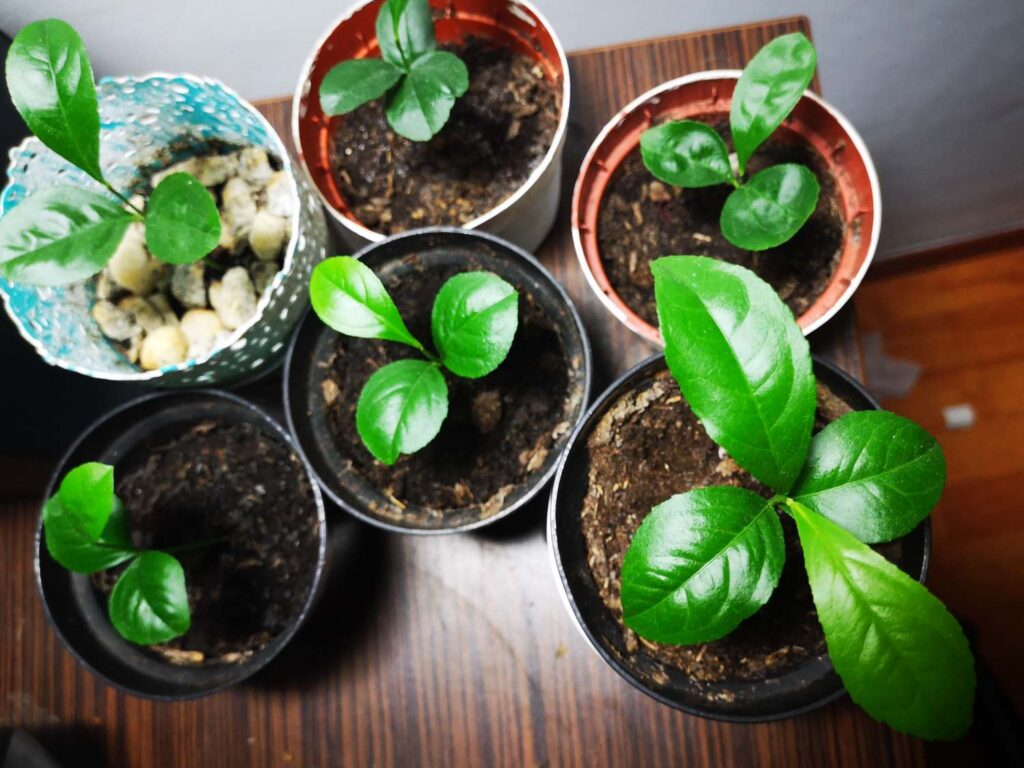
Growth Stage 3: Maturing Lemon Tree
As the seedlings mature, they require different care than young seedlings to ensure they continue to grow and produce healthy, delicious fruit. Not only will your young seedlings get taller, but they will also gain trunk girth and sprout new branches and many more leaves.
This stage can take a couple of years. Lemon trees are considered saplings when their trunk is at least 1 inch in diameter and they are 4 1/2 feet tall. They will continue to get taller (primary growth) and thicker (secondary growth.) They will even begin to grow thorns.
One of the most important factors in maturing lemon tree saplings is providing them with the proper soil conditions. Lemon trees prefer soil that is slightly acidic, well-draining, and rich in nutrients. It is important to ensure the soil is not too dry or too wet, as this can lead to root rot or other issues.
As the lemon tree saplings mature, they may require regular fertilization to promote healthy growth and fruit production. A balanced fertilizer with with either more or equal parts nitrogen, and equal parts phosphorus, and potassium, such as a 6-3-3 fertilizer but not to exceed 8-8-8 fertilizer is ideal for maturing lemon trees. Fertilization should be done in the early spring and again in the late summer or early fall.
Lemon trees should be pruned starting when they have their second birthday. Pruning should not be skipped otherwise they will become too dense and overly crowded.
Regular pruning can help promote healthy growth, increase fruit production, and prevent disease and pest infestations. Pruning should be done in the late winter or early spring, before new growth begins.
In addition to soil conditions, fertilization, and pruning, it is important to provide the saplings with adequate water and sunlight. Lemon trees require at least 6 to 8 hours of sunlight each day to produce healthy fruit. Watering should be done regularly, but not excessively, to prevent the roots from rotting.
Growth Stage 4: Lemon Tree Flowering
The lemon tree flowering stage is a crucial time in the growth and development of a lemon tree. This is the time when the tree produces beautiful and fragrant blossoms, which will eventually turn into fruit. Proper care during this stage is important to ensure a healthy and productive lemon tree.
Lemon trees should start to form buds in the winter and will typically flower in the spring or early summer, depending on the climate and growing conditions. During the flowering stage, it is important to provide the tree with adequate sunlight, water, and nutrients to promote healthy growth and flower production.
One of the most important factors in the lemon tree flowering stage is pollination. Pollination occurs when the pollen from the male parts of the flower (the stamen) fertilizes the female parts of the flower (the pistil). This can occur naturally, through bees and other insects, or can be done manually by shaking the tree or using a small brush to transfer pollen between flowers. Proper pruning can also help promote healthy flower production and fruit development.
During the lemon tree flowering stage, it is important to monitor the tree for any signs of pests or disease, as these can hinder flower and fruit production. Regularly inspecting the tree for pests and providing proper fertilization can help ensure healthy growth and flower production.
The fully bloomed flowers may only last a couple of days or a week. Once the lemon tree has finished flowering, it will perform the stage that we’ve all been waiting for… producing fruit!
Growth Stage 5: Lemon Tree Fruiting
The lemon tree fruiting stage is an exciting time for growers, as this is when the tree produces the delicious and nutritious fruit for which it is prized. Proper care during this stage is important to ensure a bountiful harvest of healthy, flavorful lemons.
Lemon trees are self-fertile and do not need to cross-pollinate with other lemon trees. One of the most important factors in the lemon tree fruiting stage is providing the tree with adequate water and nutrients. Lemon trees require regular watering, but not excessive amounts, as this can lead to root rot or other issues. Fertilization should also be continued.
Regularly inspecting the tree for pests and signs of disease can help prevent issues before they become too severe. Organic pest control methods, such as using beneficial insects or companion planting, can also be effective in managing pests and promoting healthy fruit development.
The fruiting stage usually lasts roughly 4 months and can seem like an eternity waiting for your coveted lemons to be ready to be squeezed.
Growth Stage 6: Harvesting Lemons
The lemon tree harvesting stage is the final stage in the growth and development of a lemon tree. This is the time when the fruit is ready to be picked and enjoyed. Proper harvesting techniques are important to ensure the best flavor and nutritional value.
The first step in the lemon tree harvesting stage is to determine when the fruit is ripe. The fruit should be firm and have a bright yellow color. It is important to avoid picking fruit that is still green, as it will not be fully mature and may not have the best flavor.
When picking the fruit, it is important to use proper harvesting techniques to avoid damaging the tree or the fruit. The fruit should be gently twisted and pulled from the tree, rather than pulled off forcefully. It is also important to avoid picking the fruit too early, as this can lead to a decrease in the amount and quality of fruit produced in the future.
After picking the fruit, it should be cleaned and stored properly to ensure the best flavor and longevity. The fruit can be washed with water and dried gently with a towel. It can then be stored in a cool, dry place for several weeks, or in the refrigerator for longer storage.
Lemon trees typically produce fruit throughout the year. Regular harvesting can help promote continued fruit production and ensure that the tree remains healthy and productive. It can also ensure the best flavor and nutritional value.
Growth Stage 7: The Drying Stage
Harvesting your lemon tree is a crucial step in maintaining its health and ensuring a continuous supply of fresh and juicy lemons. If the fruit is left on the tree for too long, it will eventually turn brown, dry out, and fall off. This not only results in a loss of fruit but can also lead to a decrease in the overall health and productivity of the tree.
It is important to note that lemon trees can continue producing fruit for many years, but as they age, their fruit production may decrease. It’s a good idea to continue to collect seeds to replant new lemon trees as time goes on as lemon trees don’t last forever.
Growth Stage 8: Additional Pruning, Growth, and Fruiting Cycles
The last “stage” is more of a cycle than a stage. It can live approximately 50 years. The tree will continue to grow and will require pruning to keep the tree manageable and easy to harvest. The tree will continue to want to grow taller and wider as it’s root structure continues to branch and strengthen. We hope you will enjoy your indoor or outdoor lemon for many years and hope that you will also outlive your lemon tree sprouts.

